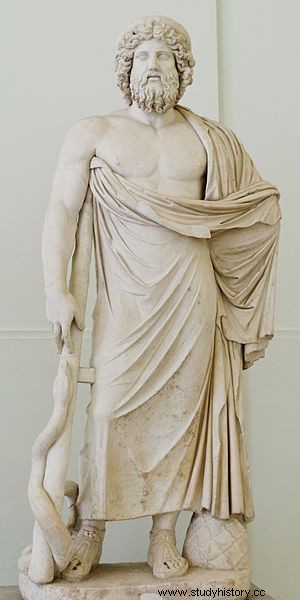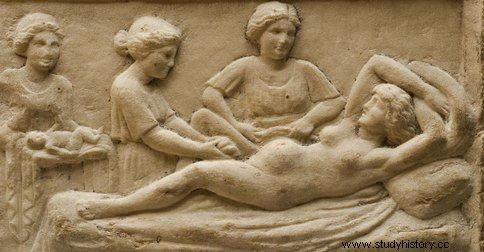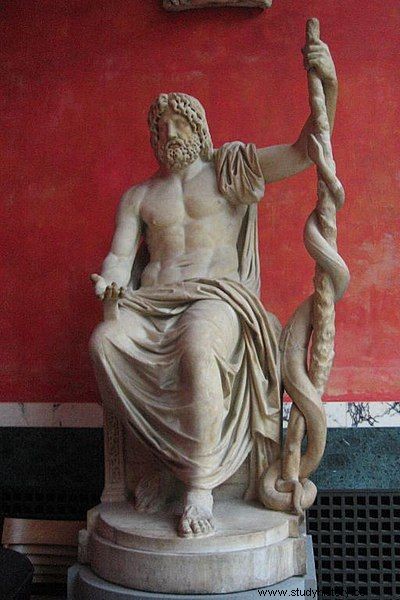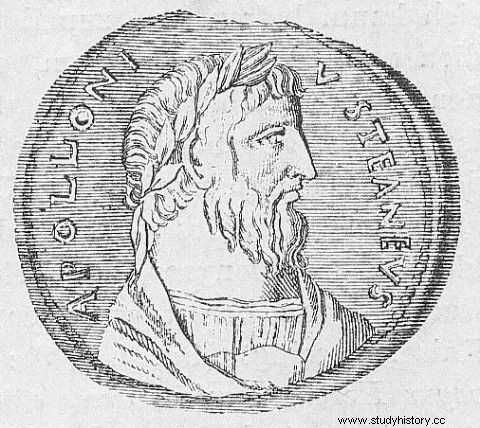Just like today, also in antiquity, not all patients trusted doctors. Suspecting that Hippocrates' colleagues collaborated with some ancient "Big Pharma" and that they did not necessarily seek their good, they preferred to turn to various types of healers and gods for help. And they were able to perform the truest miracles that adepts of conventional medicine had not dreamed of ...
Although ancient medics, healers and priests did not have the resources and knowledge that modern doctors do, their patients could not complain about the lack of care. Ancient health specialists - with a little help from the appropriate deities - were able to happily solve a 5-year pregnancy, give the sick person superhuman strength, and even bring the dead back to life. Or at least that's what the so-called iamata - steles bearing "medical records" from thousands of years ago.
By Aesculapius!
A sick person who was wary of Hippocratic doctors, could always visit the temple of Aesculapius, Theos Hypsistos, Poseidon, Apollo and many, many others. How was the "divine" therapy going? Pathologist Philippe Charlier reports:
Such a patient had to go to the temple where the healing process was to take place. There he underwent a treatment that we would today call ritualized therapy. During his stay in the sanctuary, the patient complied with special dietary and hygienic requirements, sacrificed an animal to the deity and stayed overnight in an abaton (a kind of large, covered gallery with beds placed side by side) or in a tolos (a circular building to which they could crawl snakes).
There, the sick person was visited by a heavenly healer in a dream and sent him a vision that was to accomplish the work. How? This was where the priest stepped in, interpreting God's words (of course for an appropriate payment). At this point, the therapy was complete.

Alleged statue of Aesculapius from a Roman temple (Farnese Collection at the National Archaeological Museum of Naples)
After recovering in good tone, it was commissioned to carve a stele (iamata), containing a specific case study, and then placed it in a temple, where it served as a testimony to the quality of local medical services and advertising ...
The victim could not be forgotten either, as a certain Hermon of Thasos, cured of his blindness, learned painfully. As it is written as a warning to posterity, “because he did not pay the wages for his treatment, God made him blind again. Then he returned and, having fallen asleep once more, regained his health again. ”
Miraculous birth
Could the visit to the temple and the advice of the priest really be an effective remedy? Of course, it happened that the disease had a psychological background - then the healing ritual actually brought relief. This could have happened with the 4th century B.C.E., a mute child from Epidaurus. It regained speech after the temple servant ordered him to make a promise to return in a year's time with another sacrifice for the toddler's health.
The priests themselves also had knowledge in the field of herbalism and natural medicine - and they ordained the sick (with God's blessing) actual medicines . Or at least this is the result of the Lentas stele dating from the 2nd-1st century BC, which the author wrote:
Since I had been coughing incessantly for two years, so that every day I was throwing out purulent and bloody sputum, God took care of my healing. He told me to eat arugula on an empty stomach, wash it down with seasoned pepper with Italian wine, and then eat starch dissolved in warm water, blessed ash dust with blessed water, an egg with pine resin, as well as unheated resin and an iris flower with honey. Later he ordered me to drink quince juice mixed with spurge juice, eat an apple, and then a fig with blessed ashes coming from the altar where sacrifices are made to the deity.

In one of the applications, we find information about a successful termination of a pregnancy that lasts a trifle… 5 years!
In fact, such a diet - albeit draconian - could bring relief. Rocket is a diuretic and analgesic, starch, quince and apples help with digestive problems, and spurge is sometimes used in some lung diseases. However, not all accounts on iamata are equally reliable. Philippe Charlier describes the case of a certain Kleo who lived in the 4th century BC .:
It had been five years since she was pregnant when she came to see and plead with the deity and fell asleep in the abaton. As soon as she hurried out of there and left the temple grounds, she gave birth to a boy who, immediately after his birth, washed himself in the fountain and walked around his mother.
As a result of this happy event, the healed wrote in the dedication:"It is not the size of the votive plate that should be admired, but the miracle of god, because Kleo carried a weight in her stomach for five years, until she fell asleep here and the deity restored her health."
The happy solution of a five-year (!) Pregnancy and the birth of a child who can ablution right away and march around the mother should definitely be put into fairy tales ...
Healthy as ... a rock
Historians are equally suspicious of the ancient history of Hermodicus of Lamsacus, whom the god Asclepius (the Greek equivalent of Aesculapius) healed in the 4th century BCE. Well, this man was struggling with a "terrible disease" consisting of paresis of the arms and suppuration of the breasts (most likely it was a chest infection that caused paralysis of the upper limbs and their temporary paralysis). However, thanks to divine intervention, he regained his strength - and with a vengeance!

Statue of Asclepius with a staff
Proof? His iamata was carved on a boulder that the healed patient personally managed to pick up and transport to the temple. And it would not be anything special, if not for the fact that the stele preserved in the museum in Epidaurus weighs - a trifle - 250 kilograms. And that's not the end of ancient medical miracles… As Charlier relates:
Another incident from the same time and place concerns a man healed by a serpent:he was suffering from a nasty swelling of his toe. On that day, the patient was brought by the servants and placed in a chair. When sleep overwhelmed him, the serpent that had crawled out of the Abathon healed his finger with its tongue, and then returned to the building. The man woke up healthy and told that he had a vision of a handsome young man pouring medicine on his finger.
Could the snake's lick really have such salutary (and spectacular) results? Well, even today, in the treatment of some skin diseases, animal saliva is used (it has been proven, for example, that dog secretion contains more leukocytes than human, and there are also various active substances in reptile saliva), but it seems that in the described case some ointment or ointment was used. other specific.
License to resurrection
And this is nothing compared to the achievements of a certain Apollonius of Tiana. As reported by his biographer, Flavius Philostrat, this extraordinary healer lived in the first century, was born in miraculous circumstances, and as an adult he traveled with his disciples and taught, in his spare time healed the sick, cast out demons from the possessed, and even… raising the dead. Sounds familiar?
As early as the 3rd century, Porphyry of Tire called Apollonius the pagan equivalent of Jesus in his work Against Christians, although according to other authors the miracle worker of Tiana had the advantage over Christ that he understood the language of animals.

Apollonius of Tiana
Apollonius deserved, among others bringing back to the world of the living a young girl who died just before her wedding. He wasn't the only ancient resurrector though. As Sextus Empiricus, who lived in the second century, noted, there were so many cases of resurrections (mainly due to Asclepius) that "they are countless". It is possible that this state of affairs was due to the shortcomings of contemporary medicine - it happened that doctors had problems with the precise determination of death and pronounced it too early. Then the deceased could actually "return from the underworld." It would also explain the lack of trust in medics…
The more so because sometimes the "ultimate healing" was not on time ... As Pliny the Elder reported in the first century:flames ". Well, after that he certainly had no chance of a miraculous healing…
Bibliography:
- P. Charlier, What the Dead Teach Us. Pathologist on the trail of the mysteries of history, Esprit 2015.
- F. Filostratos, The Life of Apollonius of Tyana, Nicolaus Copernicus University Scientific Publishers 2012.
- M. L. Lang, Cure and Cult in Ancient Corinth:A Guide to the Asklepieion, American School of Classical Studies At Athens, Princeton 1997.
- L. Wells, The Greek Language of Healing from Homer to New Testament Times, Walter de Gruyter 1998.
